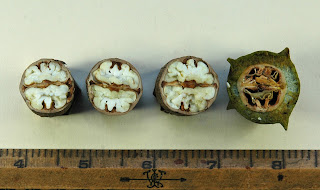On my farm, I established our pecan orchard in a field that is located within the Neosho River flood plain. The soils in this field are mostly Hepler silt loam with small areas of Osage silty clay. This area of the farm is subjected to occasional flooding. However, I couldn't resist planting pecans around my home, located up the hill just a few hundred feet from the main pecan grove. The soil at the home site is a Cherokee silt loam; a soil that was formed from river-deposited silt during the melting of the last ice age. This soil (and my house) is not subject to flooding.

By planting trees in both bottomland and upland positions in the landscape, I can see how site selection impacts pecan performance. The photos at right and above show Jayhawk and Kanza nuts collected from similar aged trees. Within each photo, the two nuts on the left were collected from trees growing in the floodplain. The two nuts on the right were harvested from upland trees. In both photos, the nuts grown in the river bottom are visually larger than the nuts collected on the upland. Sample weights (grams/nut) confirmed what my eyes could easily see (table below).
--------------------------
Site Jayhawk Kanza
--------------------------
Bottomland 7.34 6.77
Upland 6.31 6.19
--------------------------
I cracked out several nuts from each tree (photos at left and below). Of course, the larger nuts from the bottomland had larger kernels. However, what I was looking for was differences in kernel plumpness.
With ample rainfall falling during the kernel filling period this year (August 2017), upland
pecan kernels were just as full as kernels collected in the river-bottom.
So why the difference in nut size? It all comes down to internal differences in soil profiles. The surface layer of Hepler and Cherokee soils are very similar; both are described as silt loam. The important difference comes deeper in the soil profile. If your dig deep into the Hepler profile, you'll find the that the soil comes heavier (more clay) with depth. But the transition is gradual with no abrupt changes in soil texture. In contrast, the Cherokee soil has about 14 inches of silty loam topsoil which abruptly changes to a firm clay subsoil.
An abrupt change in soil texture has major impacts on the movement of water within the soil profile. Both Hepler and Cherokee are slow to drain after periods of wet weather. However, the clay pan found in the Cherokee soil creates what is known as a perched water table. Water moves so slowly into the subsoil that it stacks up in the topsoil creating a zone of super saturation. A perched water table causes the soil to lose vital soil oxygen which can lead to tree root death. Tree growing in soils with a perched water table typically end up developing shallow root systems and a pecan tree with shallow roots has a hard time competing for water during hot dry periods.
An abrupt change in soil texture between the topsoil and subsoil also impacts the movement of water upwards during dry periods. Surface evaporation and plant transpiration remove water from the upper portions of the soil. As the soil dries out, water moves by capillary action upwards through the soil. However, a prominent boundary layer, like a clay pan, will block the free flow of water by capillary action from deep in the subsoil. The result is a soil that tends to be "droughty".
A soil with a strong boundary between topsoil and subsoil does not provide a healthy rooting environment for pecan trees. A perched water table in the spring limits root growth while soil water is held unavailable in the subsoil during the hot summer. Young pecan trees respond to upland soil types by producing smaller nuts. As trees on upland sites grow older, you'll find that trees becomes stunted, upper limbs may start dying back and nut production becomes limited and erratic.
My main pecan orchard is located in the river bottom, where pecan trees thrive. The trees around the house will never be commercially viable but that's not why I planted them. I just enjoy looking out the window every morning and seeing beautiful pecan trees.






















































